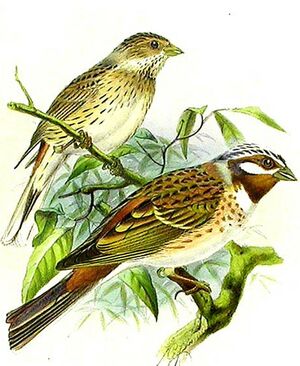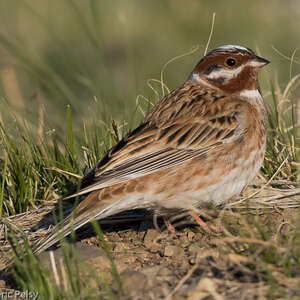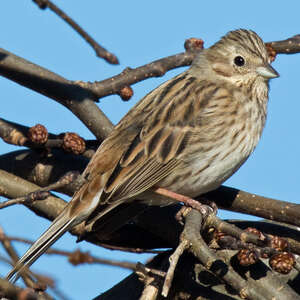Pine Bunting
Emberiza leucocephalos - Bruant à calotte blanche
Identification
The Pine Bunting is an essentially Asian species, very rare in France and more generally in Europe. The adult male, with its plumage, cannot be confused. On the other hand, female type birds that appear in Europe in winter require a minimum of discernment to be correctly identified. The bird is about the size of a Yellow Bunting, perhaps slightly larger, and like it, it has a red rump and reddish tail coverts. But the rest is different.
The adult male is recognized by its three-colour head. The cap is white, which gave it its name. This white goes down the neck, bordered by two black lines from the black forehead. The rest of the head is bright chestnut, bordered by a white half-collar widened in front. On the side, the ear coverts are white, bordered with black above and below, forming two very visible white spots. They are connected to the white mustaches starting from the bill. This is enough for identification. You can also note the red at the base of the tail as previously mentioned and the pronounced red of the lower parts. The eye is dark, the bill bicolor (blackish above and grayish pale below) and the legs pink to reddish brown. The adult male in fresh autumn plumage or in transition plumage can be more delicate to determine. The new feathers have borders that mask the colors until wear reveals them during the course of the winter. It then looks like the Yellow Bunting, but without yellow.
The adult female and the first winter birds look a lot like the corresponding Yellow Buntings. To distinguish the two species, you must pay attention to the background color of the head plumage and the lower parts. In the white cap there is normally never any yellow shade, even slight. However, one must see the birds in good conditions.Nonetheless, some female Pine Buntings, adults or first-winter, are really not very yellow, which is a source of confusion. In such cases, it is recommended to take pictures, if possible.
Subspecific information 2 subspecies
- Emberiza leucocephalos leucocephalos (e European Russia to e Siberia and ne China)
- Emberiza leucocephalos fronto (ne Qinghai and s Gansu. nc China.)
Foreign names
- Bruant à calotte blanche,
- Escribano cabeciblanco,
- escrevedeira-de-barrete-branco,
- Fichtenammer,
- fenyősármány,
- Witkopgors,
- Zigolo golarossa,
- tallsparv,
- Hvithodespurv,
- strnádka bielohlavá,
- strnad bělohlavý,
- Hvidkindet Værling,
- mäntysirkku,
- sit capblanc,
- Lerkitittlingur,
- trznadel białogłowy,
- priežu stērste,
- beloglavi strnad,
- Белошапочная овсянка,
- シラガホオジロ,
- 白头鹀,
- tallsparv,
- 白頭鵐,
Voice song and call
The song of the Pine Bunting, a series of identical notes with a different final syllable, is very similar to that of the Yellow Bunting, with the same structure and the same tone.
The call is a 'tsiuh' that is unsound and also resembles that of its congener. There are also also 'tsi' that are high-pitched and may be alarm calls.
Habitat
The Pine Bunting is a bird from the southern part of the boreal coniferous forest. It is found in open stages of this forest, on the edges, in glades, regrowth after exploitation or burning, etc.
In winter on the other hand, it frequents much more open environments, fields, meadows, heaths, steppes, coastal dunes, banks of water, clear hill slopes, etc. However, it always requires trees and bushes nearby as a refuge and as a dormitory.
Behaviour character trait
The species is common in its breeding grounds and pairs often nest side by side. It is surprising to see how afterwards the birds become gregarious and remain so during the entire non-breeding season. The stragglers to the west join other passerines, notably Pine Buntings, with which they share the same behaviour.
Flight
Dietfeeding habits
The diet of the Pine Bunting is typical for a bunting. In the summertime, it is primarily insectivorous, consuming and feeding its nestlings a range of invertebrates, including of course insects, but also spiders, worms, and small terrestrial mollusks.
In winter, there is a complete change of diet. It then turns to seeds, particularly those of cultivated or wild grasses, which it searches for on the ground in small hops. Cereals in fields or rice paddies are particularly appreciated.
Reproduction nesting
The breeding season lasts from late April to July. Most pairs nest from May onward. There are usually two successive broods.
The nest is built by the female, a tightly woven cup of grass, roots and stems, lined inside with fine grass and sometimes hair. It is usually placed in a small depression of the ground sheltered by grass, bushes or flatten vegetation. The clutch is 4-5 eggs, rarely 6, whitish and marked with small brown spots and lines. Incubation is carried out entirely by the female over a period of 13 days. The young are fed by both adults at the nest for around 9 days, then away from the nest for 1 to 3 days more.Geographic range
The Pine Bunting breeds in Asia, ranging from the Ural Mountains to the Sea of Okhotsk, at boreal and temperate latitudes beyond the 55th parallel. Birds from the western part of its range spend the winter in Southwest Asia as far south as the Caspian Sea, and along the Himalayan range. Those from the east winter along the Sea of Okhotsk in southeastern-most Russia, northeastern China, and the Korean Peninsula, pushing a foothold as far north as the center of China where a distinct subspecies, the ssp fronto, is resident.
A portion of western birds venture as far as western and northwestern Europe, North Africa, the Levant, and the Arabian Peninsula. It is a regular, though scarce, visitor to the south of France.
Threats - protection
Sources of information
- IOC World Bird List (v15.1), Gill, F and D Donsker (Eds). 2025-12-07.
- Buntings and Sparrows, Byers C., Olsson U. and Curson J.
- Les passereaux d'Europe, tome 2, P. Géroudet, M. Cuisin
- Avibase, Lepage Denis
- Birds of the World, The Cornell Lab of Ornithology
- xeno-canto, Sharing bird sounds from around the world,
Other sources of interest
 Specification sheet created on
27/07/2023 by Jean François
Specification sheet created on
27/07/2023 by Jean FrançoisTranslation by AI Oiseaux.net
© 1996-2025 Oiseaux.net
- Accipitriformes
- Aegotheliformes
- Anseriformes
- Apodiformes
- Apterygiformes
- Bucerotiformes
- Caprimulgiformes
- Cariamiformes
- Casuariiformes
- Charadriiformes
- Ciconiiformes
- Coliiformes
- Columbiformes
- Coraciiformes
- Cuculiformes
- Eurypygiformes
- Falconiformes
- Galliformes
- Gaviiformes
- Gruiformes
- Leptosomiformes
- Mesitornithiformes
- Musophagiformes
- Nyctibiiformes
- Opisthocomiformes
- Otidiformes
- Passeriformes
- Pelecaniformes
- Phaethontiformes
- Phoenicopteriformes
- Piciformes
- Podargiformes
- Podicipediformes
- Procellariiformes
- Psittaciformes
- Pterocliformes
- Rheiformes
- Sphenisciformes
- Steatornithiformes
- Strigiformes
- Struthioniformes
- Suliformes
- Tinamiformes
- Trogoniformes



























